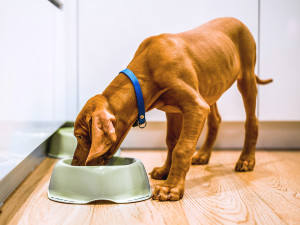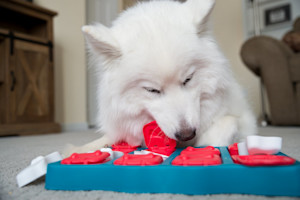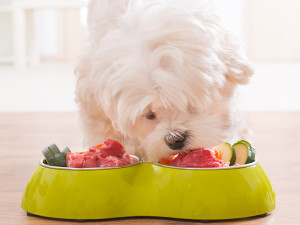What’s Actually On (and In) a Bag of Pet Food?
Want your pet to eat healthily? Dig in and learn how to read their food label.
We know: Reading the labels on a package of pet food can be exhausting. It’s hard enough to decipher our own nutritional needs (riboflavin is good, right?), let alone those of another species. All pet food labels are required to include certain important elements, but finding out where these items appear and what they mean can be difficult. Even skilled nutritional expert Dr. Marion Nestle admits that reading a pet-food label “is no simple task…and hardly anyone can make sense of them.”
There are more choices than ever these days when it comes to top-quality commercial foods, not to mention the wide array of forms the food comes in — kibble, canned, semi-moist, dehydrated, raw. Plus, home-prepared meals are becoming increasingly popular, with many people either supplementing commercial foods or replacing them entirely with meals they cook. That said, the convenience and ease of a commercial diet keep these foods at the front of the pack. This is all the more reason to learn how to differentiate among the product choices.
There are two things to keep in mind when you’re deciding what to feed your pet: First, every pet is an individual, so what one might thrive on could be an allergen to another. Second, high-quality (organic preferred) fresh ingredients trump all other factors. When preparing food at home, it’s fairly easy to control the quality. But how can pet parents know about the quality of the ingredients in commercial pet foods? It starts with deciphering a pet food label.
AAFCO Label Rules
Nutritional standards for the production of pet food are set by the Association of American Feed Control Officials (AAFCO). This non-government group is made up of state and federal representatives, as well as people directly involved in the pet-food industry. This means that people who manufacture pet food have a voice in establishing pet-food standards and most of the label requirements and feed-trial protocols. Although the Federal Drug Administration (FDA) sets rules for some of the label items, its oversight of pet-food production is still very limited.
AAFCO’s Nutrient Profiles list the minimum amounts (and minimum is the operative word here) of nutrients required by pets. The group recognizes only two canine feeding stages: “adult maintenance” and “growth and reproduction.” So, unless they’re puppies or lactating females, all dogs fall into the “adult maintenance” category regardless of their age, health status, or level of physical activity.
How to Read a Pet Food Label
There are two components to a pet-food label: marketing and informational. The former is intended to convince you that the product inside the bag or can is the best and tastiest. The content of the latter is, for the most part, dictated by the FDA and AAFCO. These guidelines specify the major components:
Brand name and product name.
Who it is intended to feed (i.e., dog or cat).
Package weight (net).
Name and address of the manufacturer. (Phone numbers and/or URLs are not required, but are good things to look for.)
Statement of Nutritional Adequacy
Statement of Guaranteed Analysis
Feeding directions
List of ingredients
Calorie Statements (optional)
Statement of Nutritional Adequacy
The Statement of Nutritional Adequacy are guidelines that must be adhered to in order to label the food as “complete and balanced.” This is also where you’ll find out how the food meets these standards for nutritional adequacy: by calculation or by live-feeding trials.
Statement of Guaranteed Analysis
The Statement of Guaranteed Analysis lists the minimum percentage of crude protein and crude fat in the food and maximum percentage of fiber and moisture; some companies also specify other nutrients. By the way, “crude” is not a quality statement; it refers to a specific method of measuring the nutrient. Carbohydrates are not included because they are not required in the diet of pets.
Feeding directions
How many cups of food to serve your pet, which are based only on the weight of the animal, so you might run the risk of over- or under-feeding if you follow them because each pet has a different lifestyle, health and activity levels. Always monitor your pet’s weight and energy level.
Ingredients
The list of ingredients, identified in the order of “predominance by weight,” or weight before processing. This is important to note when you are comparing products with different moisture contents. Also, as explained by Linda Bren in an FDA Consumer newsletter, “Similar materials listed as separate ingredients may outweigh other ingredients that precede them on the list of ingredients. For example, chicken may be listed as the first ingredient, then wheat flour, ground wheat, and wheat middlings. The consumer may believe that chicken is the predominant ingredient, but the three wheat products — when added together — may weigh more than the chicken.”
According to the AAFCO the term “meal” on pet food labels refers to the “dry, rendered product from a combination of clean flesh and skin with or without accompanying bone, derived from the parts of whole carcasses of [chicken/poultry], exclusive of feathers, heads, feet and entrails.”
The Animal Protection Institute points out that “a good rule of thumb to distinguish the major components of a food is to look for the first named source of fat on the ingredient list. Anything listed before that (and including it) makes up the main portion of the food. Other items, which may add flavor, function as preservatives or [have] dietary benefits (e.g. probiotics, vitamins and minerals),” are present in much smaller amounts.
Calorie statement
AAFCO regulations say the listing for calories “shall be distinct from Guaranteed Analysis and shall appear under the heading Calorie Content.” If a calorie statement is on the label, it must be expressed on a “kilocalories per kilogram” basis. Kilocalories are the same as the calories.
Beyond Pet Food Labels
Look for best buy dates.
The label can reveal other important information besides the ingredients. Check for a “best by” date. Most naturally preserved dry foods have a “best by” date that is 12 months from the date of manufacture. Try to find a bag that is as fresh as possible.
Keep food fresh longer.
If yours is a one-pet household and your budget can tolerate the price differential, shop for smaller-sized bags, which make it easier to keep the food fresh. Also, look for bags lined with untreated aluminum foil. Do not remove the food from the bag, but rather, store the bag inside an airtight, metal container.
Seal opened canned food.
If you feed your pet canned food and don’t use an entire can in one meal, store the leftovers in the refrigerator in a covered container. Food left in an opened can (even one with a plastic lid) loses flavor.
Dogs thrive on variety.
Bren points out: “Some animal nutritionists recommend switching among two or three different pet-food products every few months. Doing so helps ensure that a deficiency doesn’t develop for some as-yet-unknown nutrient required for good health. When changing pet foods, add the new food to the old gradually for a few days to avoid upsetting the pet’s digestive system.”
Keep an eye on calories.
If you are adding fresh or cooked ingredients to the meal (which many recommend), make sure you adjust the amount of commercial food to avoid overfeeding and weight gain.
Shop local.
When in doubt, shop at small boutique or holistic pet stores. The owners and staff are usually more familiar with their products and can help you with your buying decisions.
Ask questions.
Make sure you contact the food manufacturer if you have any questions about their products, either before or after buying it. Do not simply rely on the information from their websites.











